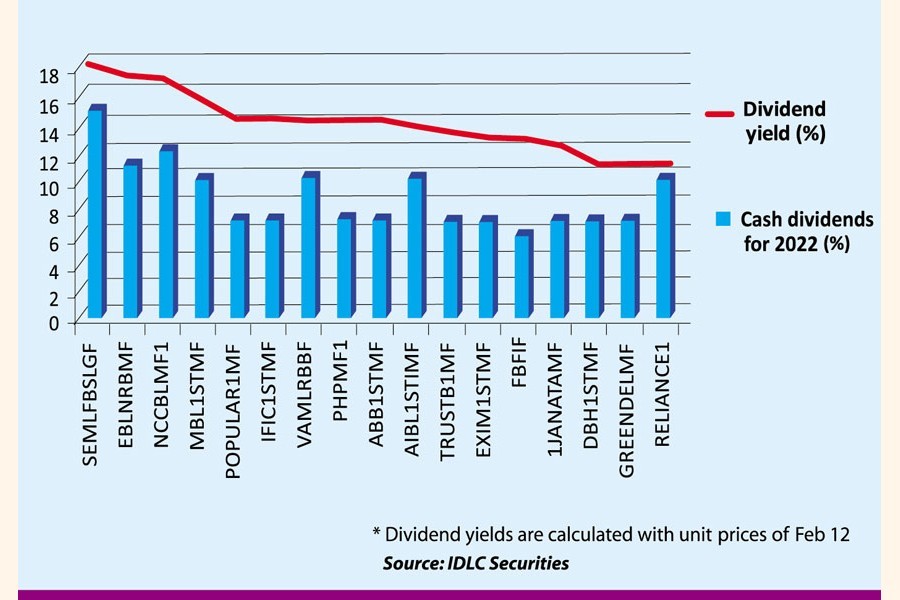Half of listed mutual funds (MFs), which have been receiving lukewarm responses from investors since the 2010 stock market debacle, surpassed all other listed securities in terms of latest annual yields.
The fund units trade mostly around the face value of Tk 10 without much movement on the bourses.
The 7-15 per cent cash dividends provided by the MFs last year take the dividend yields to 10-17.9 per cent, annualized, which are much higher returns on investments than what investors receive from other stocks.
For the calculation of dividend yields, the unit prices on February 12 were taken into account.
The data provided by IDLC Securities shows that 17 of 36 listed MFs recorded double digit yields.
Dividend yield of a stock shows how much an investor receives in annual dividend for a particular year for owning a share relative to the share price.
Since MFs' unit prices are low, dividend yield is high, meaning investors get high returns from small investments.
For example, SEML FBLSL Growth Fund sold at Tk 9.80 per unit on the record date last year and shareholders were to receive 15 per cent cash dividend.
The dividend yield from the MF stands at 15.30 per cent considering the price on the record date, while the ratio is 17.90 per cent if the current price of Tk 8.40 (floor price) is taken into account.
So, the fund could be a better investment option than the low-priced bank stocks, which, among listed companies, ensured the highest yields last year. The stock price of Exim Bank, for an instance, was highest at Tk 14.20 and lowest at Tk 10.80 in the year up to its latest record date. Having a face value of Tk 10, it provided 10 per cent cash dividend. So, the dividend yield hovered between 7.04 per cent and 9.25 per cent.
Apart from the fact that the unit prices are low, the regulatory provision that the MFs are required to disburse 70 per cent of the profits in the form of cash dividends also played a role in high yields.
Mutual Funds are assets pooled from investors for investing in stocks, bonds, money market instruments and other assets. MFs in Bangladesh are bound to invest at least 60 per cent of their assets in listed securities and generate income from sales of securities, dividends received against the holdings and interest from fixed instruments.
Since a greater chunk of the funds go to listed securities, profits of the MFs depend highly on the market returns.
The Dhaka bourse saw a market return of 2.52 per cent or 157 points in the FY22, with the DSEX closing at 6,376 points at the end of June last year.
"The market return was comparatively better during the period of latest declarations," said an official of LR Global Bangladesh.
Of the MFs, the market prices of 33 are below the face value while the remaining three are being traded marginally above the face value.
Some of the MFs distributed cash dividends out of their reserves.
SEML FBLSL Growth Fund, which ensured the highest yield, saw its earnings per unit (EPU) plunge 50.26 per cent year-on-year to Tk 0.93 in the FY22.
The income fell mainly due to a decline in financial income and income on sales of securities.
Mohammad Shafatul Islam, company secretary of Strategic Equity Management, said SEML FBLSL Growth Fund under their management was able to distribute a good amount in cash dividends with support from their reserve.
"MFs have income generated from fixed-income securities. The motto of the funds is to support the capital market," Mr. Islam said.
The MFs also get quota facility in the IPOs (initial public offerings) approved by the securities regulator. A 10 per cent quota was there for MFs, which has been recently reduced to 5 per cent in the latest amendment to the public issue rules.
Shahidul Islam, chief executive officer at VIPB Asset Management, said the performance of a mutual fund should not be judged by the dividend yield of a single year. "The funds should be judged by looking at its track record in the previous few years."
The market prices of the listed MFs are below the net asset value (NAV).
"Some cases of fund embezzlement indicate that assets are on papers only," said Mr Islam, adding that investors might have no confidence in NAVs and that is why they are reluctant to purchase units at prices even below the NAVs.
Insiders said that apart from the price erosion caused by the stock market debacle, the regulatory decision extending the funds' tenures turned away investors from the instruments.
Earlier, the securities regulator allowed the asset managers to extend the funds' tenure on the pretext of supporting the market.
The funds were allowed to issue RIUs (re-investment unit), one kind of stock dividend in deviation from the standards set for MFs.
Units were increased through the RIUs but investors were unable to realise capital gains due to lower market prices. On the other hand, the management fees of the fund managers rose because of the additional units.


